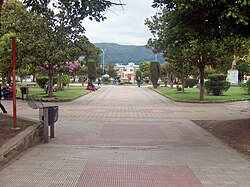Cosquín

|
||
| Basic data | ||
|---|---|---|
| location | 31 ° 16 ′ S , 64 ° 27 ′ W | |
| Height above d. M .: | 719 m | |
| Population (2001): | 19,070 | |
|
|
||
| administration | ||
| Province : |
|
|
| Department : | Punilla | |
| Mayor: | Marcelo Villanueva, UPC | |
| Others | ||
| Postal code : | X5166 | |
| Telephone code: | 03541 | |
| Cosquín's website | ||
Cosquín is the capital of the Punilla department in the province of Cordoba in central Argentina . It is located in the Punilla Valley on the Río Cosquín , at the foot of the Cerro Pan de Azúcar in the Sierras de Córdoba and today has 25,000 inhabitants, including the suburbs of Villa Bustos , Santa María de Punilla and Bialet Massé , with which Cosquín is one Local community, there are around 40,000.
The city is an important tourist center primarily because of its location in a lovely low mountain range, its proximity to the megacity of Córdoba and its festivals . The most famous folklore festival in Argentina takes place here every year at the end of January, where not only Argentine stars, but also celebrities from other Latin American countries perform. At the beginning of February, the largest open-air rock festival in Argentina, Cosquin Rock (80,000–120,000 visitors), and a few days later the newer Cosquín Cuarteto , the largest festival of Cuarteto music in the country , follows .
The Folclórico de Cosquín Festival (Folklore Festival)

For the first time the festival took place with the opening call "Aquííí Cosquíííínnnn" (Here Cosquín) from January 21 to 29, 1961 on the initiative of some citizens who wanted to establish a tourist attraction during the summer holidays. The nine days of the event are called Las nueve lunas de Cosquín (The nine moons). The festival sparked a renewal of Argentine and Latin American folklore music. The fact that the influential radio station Belgrano de Buenos Aires , among others, broadcast the festival live from 1962 onwards contributed to this. As early as 1963, the success had President José María Guido declare the last week of January to be the National Folklore Week. In 1972 the stage was named after Atahualpa Yupanqui , who won first prize in 1969. Parts of the festival have also been broadcast live on television since 1984. In 2001 the stage was renewed and replaced by a 50 m wide and 830 m² rotating stage in order to accelerate the change of musicians. There is space for around 10,000 spectators in the building.
Numerous internationally successful musicians performed at the festival, including Mercedes Sosa , Los Cantores Del Alba , Los Chalchaleros , Ramona Galarza , Los de Salta , Gustavo Cuchi Leguizamón , Antonio Tormo and Soledad Pastorutti .
Web links
- Villa Carlos Paz y Valle de Punilla
- IFAM statistics data (Spanish)
- Cosquin city portrait (Spanish)
- LiveArgentina.com - City information (Spanish)
Individual evidence
- ↑ Argentine law: Decree 1547/63
